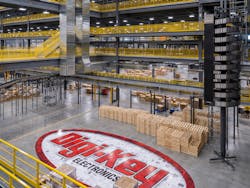What sorts of sensing technologies have improved the effectiveness and reliability of picking systems and conveyance systems?
Brian DeHaan, director of engineering, Digi-Key: Machine vision has been deployed in limited scope at Digi-Key as an empty-tray detection system and vision-based barcode reading and tray-configuration system. There are many more opportunities that could be applied to ensure quality such as picking verification, in which vision verifies the correct tray compartment was accessed by the picker. Not yet deployed at Digi-Key, machine vision is an essential sensing and verification subsystem for automated picking and augmented-reality systems.
The entire material-handling system in the PDCe facility uses presence sensing to operate the conveyor network as efficiently as possible while reducing wear and downtime. Conveyors, lifts and other equipment operate only when necessary to provide material movement.
In addition to on-screen guidance, each pick station has a lighted grid system to guide the picker to the correct compartment in the source tray.
As warehouse distribution centers continue to grow larger, how are tracking and intelligence helping to keep up with customer demands?
Brian DeHaan, director of engineering, Digi-Key: Warehouse-management systems (WMSs) provide the capability of supplying product attributes of available inventory to customers. The order tracking capability of the WMS and warehouse control system (WCS) has the information pertaining to order status that could be provided to customers; however, this has not been implemented at Digi-Key yet.
Which technologies have allowed warehouses to increase throughput rates while expanding product ranges and still maintaining accurate order fulfillment?
Brian DeHaan, director of engineering, Digi-Key: The primary means of expanding throughput rates implemented by Digi-Key is a Knapp goods-to-person (GTP) order fulfillment system. While other options were explored that expanded throughput rates, those solutions did not scale to the order volumes required by our growing business. In fact, those options compounded order consolidation and worker idle times.
GTP technology provided the means to eliminate worker stall time—the time when work is not available for the worker. And with a better decoupling of pick-to-pack—the dependency of packers waiting for all picks for an order to consolidate—Digi-Key has a design that can scale to business needs beyond 2030.
The primary element of GTP is tote-based inventory stored in an automated system. With as few as one and as many as 16 compartments in a tote, the opportunity for errors has been greatly reduced compared to traditional manual shelf storage systems. This scales the order fulfillment capacity while greatly reducing the opportunity for errors.
Because of the warehouse’s physical nature, how much of the facility’s hardware can be replaced with software in order to facilitate easier upgrades, expansions and reconfigurations?
Brian DeHaan, director of engineering, Digi-Key: Dynamic homing and order-storage-and-retrieval (OSR) slotting can provide a level of flexibility in how products are stored in a fixed storage environment. For example, when the inventory in a location has been depleted, inventory with different physical or data attributes can be allocated to the same location. The software algorithms optimize the physical space without requiring a reconfiguration of the storage system.
While not yet implemented at Digi-Key, location services that can report the location and utilization of assets such as order pickers, people movers and other mobile assets. This real-time location tracking can allow asset managers to optimize the utilization of equipment to ensure sufficient equipment is available when needed.
In general, a direct replacement of hardware with software to support upgrades, expansions and reconfigurations is not likely given the design chosen. A digital twin and machine learning is likely the next step Digi-Key will take to look for improvement opportunities to optimize the fulfillment operation.
How have automated storage and retrieval systems' roles changed over the past 10 years?
Brian DeHaan, director of engineering, Digi-Key: Scalable shuttle systems that operate in three dimensions can optimize density while reducing costs for applications that have lower throughput requirements. This can make a shuttle-based system an attractive option. Shuttle-based automated storage and retrieval systems (ASRSs) have increased weight capacity to increase storage flexibility.
Higher-density top-access grid systems such as Autostore have advanced their capabilities to provide even higher density for larger case sizes and weights.
Autonomous mobile robots (AMRs) provide a new level of flexibility in a dynamic environment. Planned and routed systems for supplies delivery in a large facility have a reasonable return on investment and can displace staff for more value-add activities. Ad-hoc transportation assistance for large or heavy items in a shipping area, for example, can provide transportation for items that do not justify a dedicated conveyor path.
Will autonomous mobile robots replace automated guided vehicles altogether, or is there room for both, based on the application or complementary functions?
Brian DeHaan, director of engineering, Digi-Key: While an AMR could replace an automated guided vehicle (AGV) very easily, there are still situations where the AGV would be the better choice. Specifically, when looking at using autonomous forklifts in narrow aisles, following a physical line in the floor will significantly reduce the chances of accidents. This can already be seen in pallet storage in PDCe.
An AMR can be forced into behaving like an AGV via programming. In that case, it would be following a virtual line in its internal map. This adds some flexibility in terms of a change in the warehouse environment. However, if the infrastructure is fixed, an AGV would be a more cost-effective solution.
How will ANSI/RIA R15.08 affect robotic solutions in warehouse environments?
Brian DeHaan, director of engineering, Digi-Key: With an increased use of mobile robots, there are questions on which safety standard to use. The B56.5 standard was developed to address safety concerns for AGVs, ensuring it stopped when deviating from its path or it encountered an obstacle. Some AMRs also have a manipulator attached which would follow the R15.06 standard. But that standard is for non-mobile industrial robots.
The ANSI/RIA R15.08 specifies the safety standards for industrial/autonomous mobile robots. There are three parts to the standard. Part 1 is for manufacturers and integrators for building AMRs, Part 2 deals with safety requirements for fleets and systems, and Part 3 will provide safety requirements for users. Part 1 also defines what an industrial robot is vs. an AGV vs. an AMR.
In essence, R15.08 standardizes the safety specifications for AMRs. This will ensure that, no matter which AMR manufacturer is used, they will all react in a similar way in a given situation.
Given the extraordinary percentage of manual operation in most distribution centers, will the 24/7 fully autonomous warehouse order-fulfillment center ever become commonplace?
Brian DeHaan, director of engineering, Digi-Key: At some point in the future, a fully autonomous warehouse will become more common. There have been some examples of warehouses with more automation than Digi-Key currently employs. These systems use full retail packaging or cases rather than single pieces. Given the number of value-added services that Digi-Key offers, that type of system is less likely to be used.
About the Author
Mike Bacidore
Editor in Chief
Mike Bacidore is chief editor of Control Design and has been an integral part of the Endeavor Business Media editorial team since 2007. Previously, he was editorial director at Hughes Communications and a portfolio manager of the human resources and labor law areas at Wolters Kluwer. Bacidore holds a BA from the University of Illinois and an MBA from Lake Forest Graduate School of Management. He is an award-winning columnist, earning multiple regional and national awards from the American Society of Business Publication Editors. He may be reached at [email protected]

Leaders relevant to this article:


